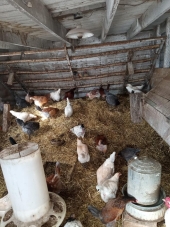8x14 gives you 112sq ft. I would be comfortable with 50-60 layers in there, I don't want any stress from crowding on laying hens. Even though you are planning on them only being in there to sleep, I would leave enough space so they can stay in all day if needed. When I move chickens into any new space they stay in full time for a couple days. Or if I suddenly have predator pressure, again they may stay in for a few days until I can sort out my predator problems. I don't like to let layers free range until noon, after they have laid most of their eggs for the day, otherwise they may go find a nice tuft of grass or log to lay under. Ventilation is your friend. if most of the bottom of the mobile coop can be mesh that poop falls through, that saves you a lot of cleaning and it will help a lot to evenly distribute manure. If you have layers in a mobile coop you want nest boxes to be accessible from outside the coop.
My layers now get a permanent coop to free range from. I found moving them to a new coop stresses them out and they may stop laying on me. I have 2 chicken tractors and 3 chickshaws that I now only use for growing stock. I hatch my own chicks, butcher my extra roosters, sell some pullets and sell my year old layers every year. my tractors and chickshaws are all 6x6x2 ft, 36sq ft. I can fit a lot of small chicks in them but have to divide them more as they grow. I can fit about 20-25 pullets in a tractor or chickshaw until a couple weeks before they start laying. Roosters, no more than 12-15 by the time I am ready to butcher them, 3-4 months and they dress out 3-3.5 lbs. So pretty small birds.









